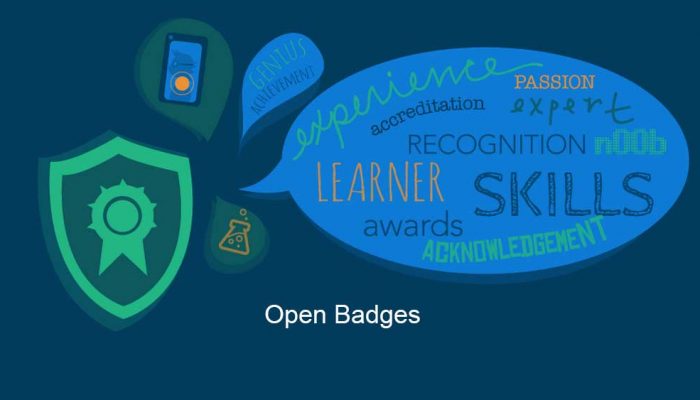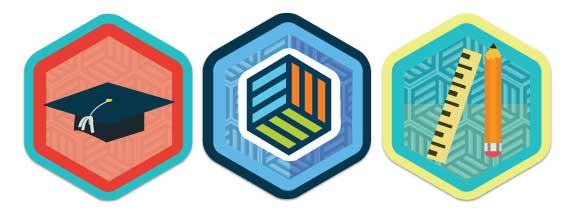Learn about the benefits of constructing a multi-year internship from a MLIS student's perspective.

Open Digital Badges: the New Education Credential
You may have earned a badge in your life. Often when people think of badges, they think about the Girl Guides or Boy Scouts and earning a badge for woodworking, baking, or volunteerism.
Badges have also seen wide adoption in video game environments where players will earn badges for completing small tasks or showing mastery over a particular skill. With the growth of mobile technologies and app-based social interactions, recognizing user engagement and tracking activities using badges have proven to support the development of online communities. All this indicates that badge-based credentials for activities and skills that aren’t necessarily a part of traditional educational environments are not a new thing.

What are Digital Badges in Education?
Badges are a digital representation of a skill, behaviour, knowledge, ability or participation in an experience. What makes this digital symbol unique is the attached metadata. The metadata of a badge is “baked-in”. The “baking-in” process allows issuers to provide information about why the badge was earned that is then attached to the badge image. This information, or metadata, attached to the badge will include the criteria for earning the badge, the issuing organization, and evidence of earning.
Often digital badges are referred to as “open.” An open badge refers to the open standard that allows an earner to pull together collections of badges from multiple spaces to create a personal learning story. The portability of the badge from the space where it may be earned (e.g. inside a course) to a profiled space speaks to the learner-focused nature of the credential. There are several spaces to store digital badges. The Mozilla Backpack provides a single profiled space where digital badges can be stored from multiple issuers, organized to be made public or private, and then dispersed to multiple social networks like LinkedIn, Google+, and Facebook.
While open digital badges (OBDs) are a relatively new educational technology, there is a lot of conversation about how they will affect education, especially in the spaces between traditional and formal education environments (e.g. extracurricular). The ability of OBDs to provide micro-credentials, evidence of learning, and enhance learner autonomy, are but a few ways by which badges are being highlighted as a possible revolutionary change for education.
Micro-credentials
OBDs provide the opportunity to identify and credential several skills, behaviours, knowledge and/or abilities that make-up a higher level of understanding around a topic. For example, web design skills require an understanding of design elements including colour, contrast, and typography. OBDs can be issued for each of these design literacies that are a part of the larger web design principles topic. These OBDs, or micro-credentials, can provide a way by which a learner can be acknowledged for engagement, whether it is a seminar, workshop, or online tutorial. This is important because it allows the learning process to be more visible across spaces (e.g. classrooms, websites, etc.) and provides a greater understanding of the skill-sets acquired by the learner.
Learner Autonomy
While OBDs can provide a better understanding of an earners learning, the freedom to showcase and share this activity is increasingly an important element of the badges themselves. Learning data is often held within the hands of the institutions that govern credentials. For example, a transcript is administered from the academic institution from where the coursework was completed. OBDs are not seeking to replace transcripts; however, they do offer a learner a great deal of autonomy over how they portray their abilities. The power to showcase skill-sets through OBD collections, allows badge earners the ability to build a “picture” that is customizable by context (e.g. online resume, learning portfolio, etc.).
Evidence of Learning
The metadata attached to an OBD provides a level of authority over the statements made by the earner. While the metadata provides a way to track who issued the OBD and why, the evidence attached to the badge provides the greatest potential for badge consumers. For example, a badge developer can create a series of HTML and CSS badges and the evidence is a fully developed and coded website. The ability for a consumer of these OBDs to experience the work of the badge earner provides greater authority over knowledge and skills claims made by the earner. What if a resume that claimed excellent oral skills would have a badge that linked out to a video presentation as evidence?
Getting Involved with Badges
There are a number of ways to learn more about open digital badges, the easiest is to become a badge earner yourself. Badge 101 from Mozilla provides a basic tutorial on what badges are and how they can be used. Digital Me and Peer 2 Peer University offer a number of badge earning opportunities focusing on a number of topics.
To learn more about creating your own badges, Open Badges UBC offers a number of tutorials to develop a badge framework. Credly offers a simple platform to develop and issue badges, while WordPress and the BadgeOS Add-on offer a platform to develop a learning environment and issue portable badges.
Additional Reading
- Educause Open Badges
- HASTAC – Digital Badges: An Annotated Research Bibliography
- Mozilla Open Badges
Erin Fields is a Liaison Librarian and Flexible Learning Coordinator for the University of British Columbia Library. She is also the Open Badges UBC Lead. Twitter: @emefie E-mail: erin.fields[at]ubc.ca.



